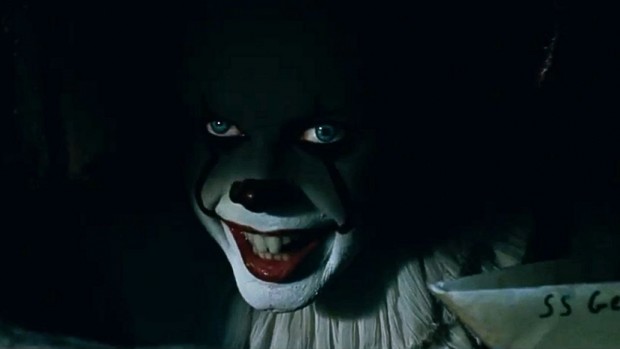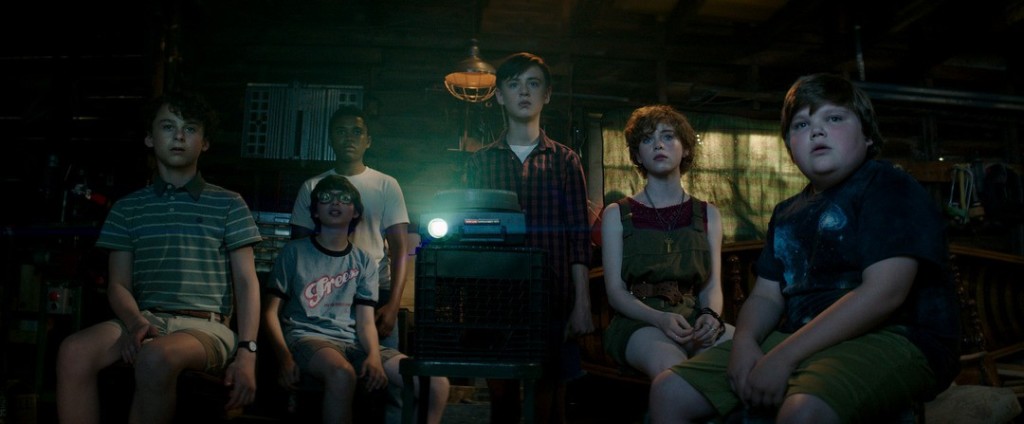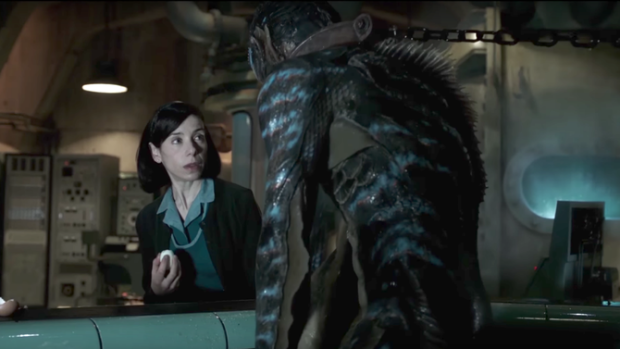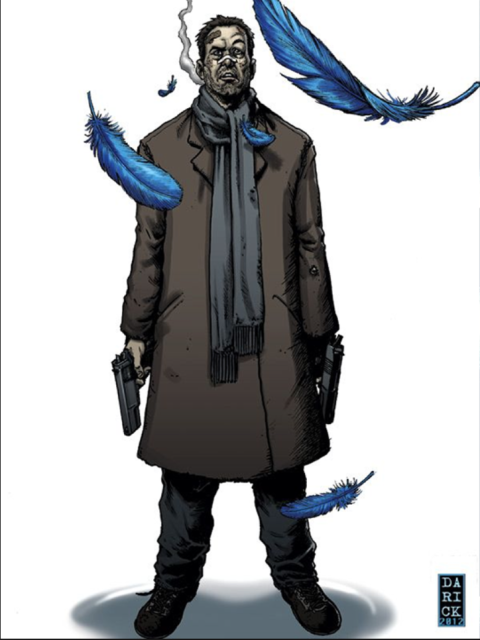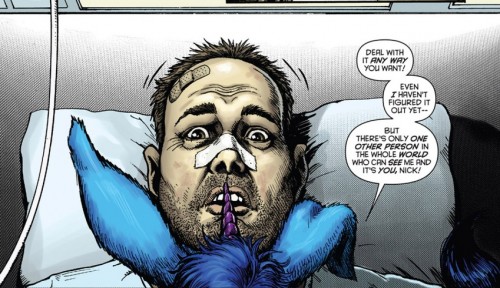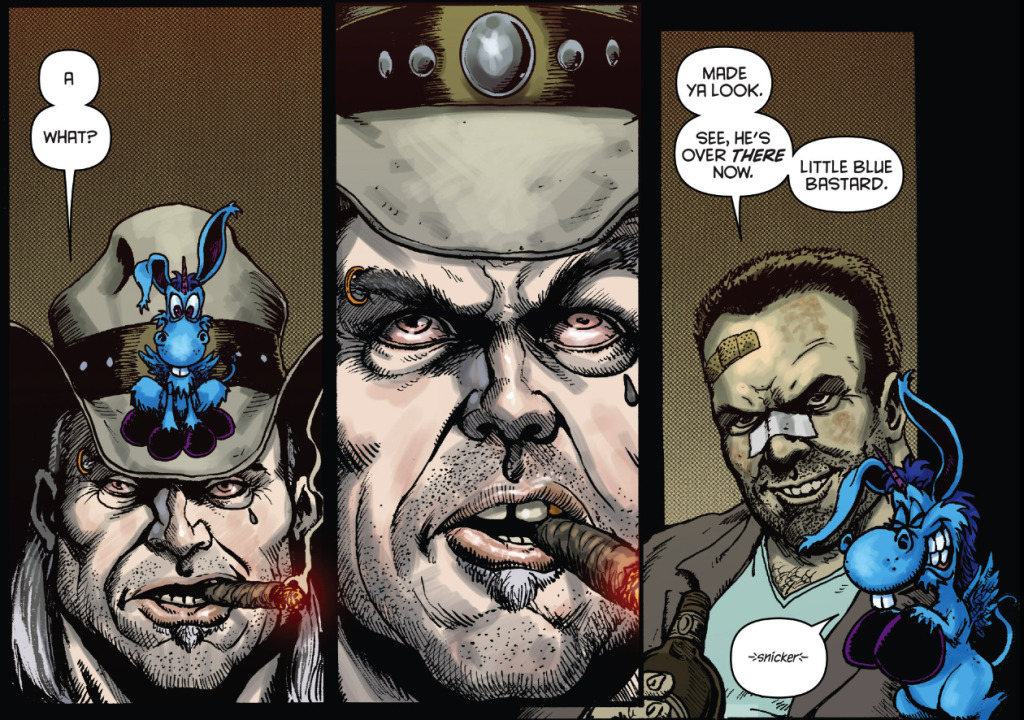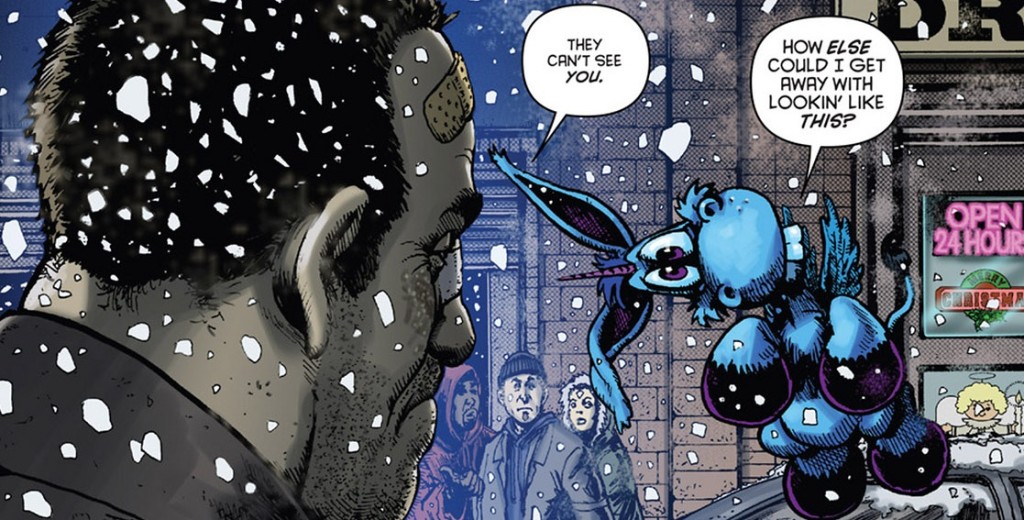Search Results for: F word
Genre: Event Horror
Premise: When a group of young kids begin seeing a demonic clown around their small town, they suspect he may have something to do with all the local kids who’ve gone missing over the years.
About: You’ll float too. After the chillingly bad TV movie version of “It,” in the 1990s, Stephen King’s most notorious novel was all but discarded as a vessel for adaptation. But in recent years, a King resurgence resulted in a newfound desire to produce a feature film based on the material. The problem was length. “It” is a huge book, 1489 pages, yet it wasn’t the kind of book you could build a trilogy around. Finally, someone came up with the genius idea to split the book in two – the children’s side and the adult side – and build a movie around both. This is the children’s side. And holy heck did it kick ass this weekend at the box office, pulling in $117 million, doubling the next highest horror opening of all time.
Writer: Chase Palmer & Cary Fukunaga and Gary Dauberman (based on the novel by Stephen King)
Details: 135 minutes
Let me start off by dispelling a myth Hollywood likes to propagate. “We’re putting out good movies. People just aren’t showing up.” That statement is nowhere close to true. For the past five years, Hollywood’s been upchucking retreads they only barely convinced us to see the first time around. They haven’t been trying for awhile now and the audience is calling them on it. You have to listen to your audience, Hollywood. They want something new. And in this case, they proved it. They wanted Event Horror.
So what is this thing I’ve been talking about all week that’s going to become the hot new thing? This “Event Horror?” How is Event Horror any different from Normal Horror?
To explain this, let’s go over the current Hollywood horror formula. Throw a group of characters into a single location (cabin, haunted house, deserted warehouse, woods), add scary element (monsters, ghosts, zombies, leprechauns), let the scares take place.
The reason this formula is rarrrrrely messed with is because it works for all three points on the triangle. Hollywood loves it because single location movies are cheap to produce. Writers like it because this is the preferred setup for building believable horror – locking characters into a location with nowhere to run. And audiences like it because the setup is inherently scary.
This is why “It” feels so different. It’s not just a bunch of one-dimensional characters packed into a haunted house. We’re getting to see these characters back in their homes, we’re getting to see them hang out together in their everyday lives. But, most importantly, we’re seeing an unrestrained group of characters. They can move about freely. It’s this “open-ended” character-driven adventure setup that makes this more of an “Event.” It feels bigger and less simplistic than your average horror movie. It’s horror opened up.
For those who haven’t seen the movie or read the book, “It” follows a group of 13 year old kids in the small town of Derry, in 1988 (updated from King’s original 1950s setting). The group leader is a kid named Bill who lost his kid brother, Georgie, to mysterious circumstances last year. Everyone else knows Georgie is dead. But Bill holds out hope that he’s still out there, along with all the other kids who have gone missing from Derry over the years.
One by one, Bill and the rest of the “Losers,” as they call themselves, are visited by a creepy clown who goes by the name, “Pennywise.” Pennywise performs a slightly different bag of tricks from your average clown. He eats children, as we (spoiler) see in the script’s nail-biting opening scene. Bill believes that Pennywise is holding Georgie hostage, and rallies the troops to infiltrate Pennywise’s domain and get Georgie back. But the kids realize that this… “It”… they’re dealing with is more powerful than anything they’ve ever dealt with in their lives.
Okay, now that I’ve emptied my book of praise all over the decision to make It, did the movie – and script – live up to the hype? It did. And that’s not to say there weren’t roadblocks along the way. In fact, the very thing that makes “It” different is what causes the writers so many problems. This results in a choppy narrative that was constantly in search of calmer seas.
What the hell are you talking about, Carson?
Earlier I was talking about the traditional horror film. For argument’s sake, we’ll call it the “cabin in the woods” scenario. Put a group of characters in a cabin in the woods, take away their car (it’s broken for whatever reason), unleash some evil entities on them, and you’ve got yourself a horror film.
In this scenario, coming up with scares is easy. The characters can’t go anywhere, so you just send monsters at them and they have no choice but to fight back.
Because “It” is open-ended and the characters aren’t restrained, the writers are constantly forced to come up with scenarios by which our heroes would willingly seek out dangerous situations. Either that or manufacture ways to get them into places where horror might occur, even if it doesn’t make a lick of sense.
For example, Ben (the “fat kid”), is reading at the library about the infamous Easter Massacre weekend in Derry 30 years ago where 100 people died. As he’s reading this, he spots a trail of flaming easter eggs that lead down to the basement. So Ben simply… FOLLOWS THE EGGS DOWN INTO THE BASEMENT. It’s here, of course, that he runs into a headless child and Pennywise the Clown. This is as manufactured as it gets. Nobody in their right mind would be dumb enough to do what Ben did. But the writers don’t have much choice. They have to push these characters into scary situations somehow.
Or Beverly, the lone girl in the group. There’s a scene where she gets home, goes to her bedroom, and a postcard Ben secretly planted in her bag pops out. On the back, Ben’s written her a 12 word poem. For some odd reason, Beverly rushes into her bathroom, locks the door, sits in her tub, and reads the poem. At the time I’m thinking, “Why is she going into the bathroom to read this? The poem isn’t War and Peace. It’s 4 lines long.” Then, as she’s reading it, something starts calling her from the sink. Ohhhhhhhhh, I realized. That’s why we had to manufacture this artificially closed-door bathroom scene. So something could attack her in the sink.
You see, this is why the “trapped” scenario is the preferred horror scenario to go with. You don’t have to force scary moments like this. They come to the characters organically.
Lucky for “It,” it has a trump card. Pennywise. This is easily the most iconic horror monster of the decade. He’s a perfectly crafted evil entity. So even when we do hit these manufactured scares, we forget about them the second Pennywise hits the screen because he’s so damn scary.
I have to give the producers props for casting relative unknown Bill Skarsgard. He’s so good in this. And the character creation and the make-up and the attention-to-detail (how the left eye is a little lazy). Wow. This is the kind of monster that will give kids nightmares for years. We can debate whether that’s a good thing or not in another post.
And the characters were great. To me, “It” is Stephen King’s magnum opus. Almost all of his characters in future books are variations on these characters. But these characters were the OGs. And the difference is, he really thought about these kids’ lives. Every kid here has a legitimately tense living situation at home that informs how they act in the outside world. I don’t think King ever tried as hard as he did with this group. And we’re the beneficiaries for it.
I felt that the plotting in the film was strong. The defining choice was having Bill search for his brother. That made sure that the characters were ACTIVE – that they were out there trying to achieve something. Without that, the characters are just waiting around for bad things to happen, and that’s where plots fall, where second acts deflate. So always make sure you’re injecting ACTIVE STORYLINES into your scripts, guys.
There’s a reason this movie made 117 million dollars this weekend. It was an event. It was a spectacle. It was more than your average horror offering. So I’m expecting this trend to pick up, hopefully extending into the spec market. It’d be nice to have another lane to sell scripts in other than biopics and female John Wicks.
[ ] What the hell did I just read?
[ ] wasn’t for me
[xx] worth the read
[ ] impressive
[ ] genius
What I learned: Sometimes, in order to find something original, you have to take a genre out of its comfort zone. Sure, horror works best in tight isolated locations where your characters can’t leave. But that’s also where everything’s been done before. Leave that setup behind to find new, potentially unknown, horror avenues to explore.
P.S. Stay tuned Thursday. I’m going to break down the rejected “It” script from Cary Fukunaga to see what they changed.
Make sure to get those amateur entries in. There WILL be an Amateur Offerings this weekend. Title, Genre, Logline, Why We Should Read, plus a PDF of your script to carsonreeves3@gmail.com
Genre: Period
Premise: During World War 2, a famous Jewish director was coerced by the Nazis to produce a propaganda film showing the concentration camps as a spa for Jews, all while being a prisoner in one. Based on the true story of Kurt Gerron.
About: For the past seven years, I’ve been writing, directing and producing my own short films. Since my love for making movies is bigger than my wallet, I almost went bankrupt because of it. With that said, a year ago I wrote this screenplay after a FULL YEAR of research. The story is full of irony, and I never understood why no one had made a movie about Kurt yet.
Writer: Marcos Vaz
Details: 116 pages
It’s so great to hear that Marcos is out there doing exactly what I told you to consider at the end of yesterday’s article. Stop waiting for people to give you approval. Bypass the bullshit and be your own approval.
With that said, if this is Marcos’s plan for a first feature, I’d probably advise him to write a cheaper movie first. For those unfamiliar with budgets, any sort of period film is going to cost a lot of money, because you’re recreating a world that no longer exists. Old costumes, old props, old locations, old looks. That gets expensive fast.
However, this is obviously a passion project for Marcos and what I’ve found is that if you are going to make your own movie, intense passion will inspire others to join your cause. People will want to be a part of your movie and they’ll help you find ways to overcome financial restraints. That’s how a ton of movies get made.
So let’s see if the writing matches the passion here.
Kurt Gerron is a famous Jewish actor, writer, and most prominently, director. His plays are legendary. And he’ll be the first person to tell you that. This guy’s got one hell of an ego on him.
When Gerron and his wife, Olga, are rounded up by the Germans and sent to a concentration gamp in Czechoslovakia called Theresienstadt, they receive special treatment from the start. The head commander at Theresienstadt, Karl Rahm, is a huge Gerron fan. So, at first, things are going swimmingly.
Then Rahm gets word that the Red Cross will be visiting soon. They want to make sure that the Germans aren’t violating any human rights. He becomes concerned that nobody here looks happy (I wonder why). So he gets this idea: Have Gerron put on a play. People will have fun producing it. People will have fun watching it. It should lift the spirits of the camp so that everyone’s busting a gut by the time the Red Cross arrives.
Meanwhile, Rahm is putting together his own “play” – as in, he’s going to make the prisoners act like this place is a blast. He’s got scripts for the kids and the prisoners and the staff, who all must hit their marks, say the right things, smile and convince these pesky Red Crossers that everything is just wonderful.
Gerron speeds through pre-production but isn’t able to get a show together before the Red Cross arrives. Strangely, that turns out to be no problem, because the Red Cross found everything to be lovely, even going so far as to write a glowing letter that appeared in all of the world’s biggest newspapers.
Because things went so well, Rahm gives Gerron another task. He wants him to film a documentary of Theresienstadt and make it look like a vacation getaway. Gerron is thrilled that he still gets to put on a show and gets back to work.
Unfortunately, with the Russian army closing in and the end of the war nearing, Rahm is forced to ship as many Jews as possible to the killing camps, and Gerron ends up being one of those prisoners. In the end, he dies in the gas chambers of Aushwitz.
Okay Marcos. I’m going to get a little intense here. But it’s only because I see a lot of potential in this. Unfortunately, if we’re going to meet that potential, we’re going to need a page 1 rewrite. And that’s because the plotting is all over the place. The King’s Fool has no structure.
Gerron gets to this concentration camp and his mission is to produce a play that makes the prisoners happy so they won’t incite suspicion when the Red Cross arrives. This is a strange goal for a movie, since you’re basically building an objective that the audience wants the hero to fail at. If our hero succeeds, a camp full of Jews lives on in misery. Not exactly a situation to root for.
In addition to this, we have this odd secondary play going on where Rahm is directing all of the prisoners to follow a script for the Red Cross. I must have asked myself a thousand times, why wouldn’t you combine these two storylines into one and have Gerron be the one who’s directing the pretend happy camp?
Because clearly, Marcos had trouble plotting them both. First of all, the prisoners never got a chance to see the play! Which I thought was the whole point – they would see it, be happy, and that happiness would convince the Red Cross that everything was great. Instead, the Red Cross shows up, and decides everything’s great anyway. So then what was the point of the play plotline?
As if this wasn’t problematic enough, there were still 42 pages left in the script! And the main plotline was over! What do you do now? Marcos decides to introduce a new plot where Gerron is asked to direct a documentary of the camp. That becomes the driving force for the rest of the film.
Because this plotline comes on so late, it doesn’t have time to properly build. And by the time it does gain steam, we have to end it. Which puts a confused exclamation point on this structurally schizophrenic film.
I will say that I loved the moment in Aushwitz where he and his wife perform this dazzling scene for the camp, only for us to find out in the closing title cards that they were killed as soon as they got off the train. The problem was, it was so clumsy getting here that we can’t appreciate the greatness of this scene.
This goes back to advice I routinely give on the site yet still writers refuse to listen. Keep your story simple. The more you complicate things, the worse your script is going to get. Unless you’ve written 20 scripts and understand how complexity works in plotting, keep it simple.
Throughout The King’s Fool, it seemed like Marcos was in way over his head. If he just would’ve simplified the plot, he’d have been fine.
That plot needs to be one of two things. Either Gerron is the director for the “pretend happy camp” Rahm needs ready for the Red Cross. Or Gerron directs the documentary of the camp so that it looks like a vacation spa. One of those two is your movie right there. And it’s probably the second one.
Not only would this be good for the film’s structure, but it would allow us to add some heroism into the story.
In the current draft, we learn that the Russians are getting closer. You’ve also built up this death sentence storyline where anyone who gets on the transports is going to the death camps. You could easily work those two elements into a heroic moment for Gerron.
While shooting a scene, I could see him learn that 2000 prisoners are about to be sent away on the transports. Gerron storms out and insists that they bring the prisoners back. “I need them for extras. We have to make this look real.” And there’s this big hubbub where Rahm won’t budge and neither will Gerron, and finally Rahm relents, giving him his extras, and Gerron just saved 2000 people.
I don’t know if stuff like this happened of course. But you need to look for moments LIKE this. Where the main character actually does something heroic.
More importantly, though, the plot needs to be simplified. I do believe there’s a movie here. This is an interesting setup. But holy heck do we need a proper plot.
Script Link: The King’s Fool
[ ] What the hell did I just read?
[x] wasn’t for me
[ ] worth the read
[ ] impressive
[ ] genius
What I learned: You don’t want to have to restart your story on page 75. If you have to give your main character an entirely new goal at that point in the story, there’s probably something wrong with your structure.
What I learned 2: When you include singing in your script, make sure to italicize all of it to visually differentiate it from regular dialogue.
Genre: Fantasy/Drama
Premise: A young mute woman who works for the government in the 1960s stumbles across a top secret project, an intelligent amphibious creature, and falls in love with it.
About: You may have heard about The Shape of Water recently. Famed filmmaker Guillermo Del Toro’s newest movie screened at the Telluride Film Festival last week and received one of those famed 20 minute standing ovations films seem to receive a lot of these days (and that have nothing to do with publicists. Nothing at all). But seriously, the word on this one is that it’s great. My issue with del Toro has always been that his superior filmmaking skills have masked the clumsiness of his pen. Which is why I wanted to read this script before seeing the film. If this works on the page, then maybe del Toro will have finally created something that isn’t just fun to look at.
Writers: Guillermo del Toro & Vanessa Taylor (based on an idea by Daniel Kraus and Guillermo del Toro)
Details: 94 pages
One of the great crimes we commit as film consumers is allowing others to tell us what to like.
Guillermo del Toro’s career beginnings coincided with the rise of Ain’t It Cool News. AICN’s creator, Harry Knowles, fell in love with del Toro, praising him religiously on the site, and since back then AICN was the only movie site in town, every movie geek followed suit and fell in love with del Toro as well.
Even I fell into the trap. Watching his movies with a distinct feeling of boredom, I figured I must be doing something wrong – watching it the wrong way or focusing on the wrong thing. And when his movies were over, I’d often ponder, “Even though I didn’t like this, everybody else did so I must be wrong.”
Now that I can think for myself, I know why I’ve disliked so much del Toro. His writing is sloppy. His plots are often flighty, it’s not always clear what the focus is, and he has major issues finding a consistent tone. To this day, going to watch the 2001 del Toro flick, The Devil’s Backbone, remains one of the most perplexing moviegoing experiences of my life. All the critics had talked about how great the film was. Yet what I saw was a wandering inconsistent genre-confused mess.
This is where The Shape of Water gets interesting. Del Toro has wisely brought in a second screenwriter, Vanessa Taylor. I like Vanessa Taylor’s writing. I remember back in the early days of Scriptshadow when I read her first script (then titled “Untitled Vanessa Taylor Project”). It chronicled an older couple going through marriage problems. It’s a script that should’ve been boring. Yet Taylor found a truth and authenticity to the relationship that elevated it, then mixed in a hint of humor to turn it into one of the most memorable scripts of the year.
Taylor would go on to win the highly coveted Divergent assignment, and she’s currently scripting the live-action Aladdin movie. It always fascinates me to see writers who not so long ago were scripting these tiny little “nothing” movies now writing some of the biggest films in town. It’s a reminder that success CAN and DOES happen. You just have to write something that resonates with people and you’re on your way.
Anyway, due to these two creative voices, one I detest and one I enjoy, I have no idea what to expect from Shape. But I’m hoping for the best.
The year is 1963. The town is Pittsburgh. We’re talking the epitome of grimy blue-collar America here. Elisa is a rather unconventional representation of that world then. She’s a 35 year-old mute spinster who lives in a small apartment by herself. The highlight of her day is 2 minutes of masturbation in the tub before work.
At least Elisa has a kinda-cool job. She’s a janitor at a secret government underground facility downtown. She cleans rooms where scientists test their latest jet engines or cutting edge (for 1965) robotic arms. Because Elisa never talks to anybody, she’s generally overlooked. Which is probably how she gets into this mess in the first place.
You see, the government brings in their most top secret project yet – an amphibious man-like-thing that lives in water. This is such a big deal that they have to bring a high-ranking military man, Strickland, in, to oversee experiments on the creature. As you’d expect, these experiments are brutal. They figure out, for example, that the creature can only survive outside of water for 30 minutes at a time. So they observe him while he’s left out past 30 minutes… you know, just to see how intensely he suffers.
Because Elisa is in charge of cleaning Amphibian Man’s room, the two start sharing little looks, which leads to her signing him, which leads to him signing back, which leads to them falling in water love. When the intensity of the experiments are ratcheted up, Elisa can’t stand by and do nothing. So she orchestrates an escape plan and takes the creature to her home!
This, naturally, results in a big hubbub at the facility. Strickland starts asking people if they know who’s got him. Several of Elisa’s co-workers who were aware she had an affinity for the creature are on the verge of cracking. So it’s only a matter of time before Elisa is discovered. This leads to a race to free Amphibian Man back into the sea.
Let’s start with the good and hope it lasts longer than a sentence. The Shape of Water is an ORIGINAL IDEA. That needs to be commended. These days, auteur directors are becoming our only outlet for original ideas and that sucks. But I want to start there because I believe in getting more original ideas into theaters even if I don’t personally like those ideas. I mean, isn’t that the point? Hollywood’s stuff is so homogenized and demograph-tested that it’s guaranteed not to be unlikable. With original material, that guarantee isn’t there. Which is why original ideas are so thrilling. You don’t know what to expect.
As for where The Shape of Water falls on the ‘like’ spectrum, it most certainly depends on how big of a del Toro fan you are. If you aren’t a fan, like myself, you see cracks in the story everywhere.
Let’s begin with our mute main character. Yes, that sound you heard was me sighing. Mute main characters. Deaf main characters. Both are crutch-device screenwriting at their worst. The idea behind a deaf character is that they’re the ultimate underdog. It conveys a writer so desperate for you to love their main character that they will go to the absolute extreme to do so.
Of course, it’s for this very reason that it never works. We’re hyper aware that you’re pining for our sympathy, so we go running as fast as we can in the opposite direction. Once the viewer is aware of the writer, there is no suspension of disbelief and the point of the story is moot.
The only time these things work is when – and I just talked about this yesterday – you explore these things AUTHENTICALLY. If you study and research what it’s really like to be a mute, what someone like this goes through on a day-by-day basis. And then you bring that very specific life experience into the character, then yes, it’s going to be great.
But writers rarely do this because it takes time and it’s hard. It’s much easier to slap a physical flaw onto a character in the cheap hope that the audience instantly sympathizes with them despite knowing nothing about them. It’s a screenwriting trick, the very definition of a gimmick. And for any frequent filmgoer, they see through it immediately. (spoiler) And don’t even get me STARTED if, late in the script, the mute character finally talks.
Not only that, but mute characters aren’t conducive for filmic storytelling. Readers don’t enjoy reading entire scripts and not seeing a single line of dialogue from their main characters. It’s hard to reconcile that. Which is why, if you’re going to do it, you should be a writer-director, like del Toro, who doesn’t have to run the script by anyone to get it made.
Even if you can get past that, you still have to deal with del Toro’s biggest weakness – his wildly inconsistent tone. This is something you see in all his movies. At best, it’s annoying, at worst, it’s uncomfortable. For example, in The Shape of Water you’ll have a zany zoinks scene where Elisa will nearly get sucked into the giant jet engine while cleaning, and then, later in the film, an extremely awkward scene where Strickland is borderline raping his wife. It’s like, what kind of movie are you trying to make here??? You shouldn’t even have your main character masturbating in a tub every morning. This is a fantasy film. Not 9 and a half weeks.
I’ll finish by saying this. In the water-based love story sub-genre, The Shape of Water finishes above Lady in the Water but below Splash. So that’s something I guess.
[ ] What the hell did I just read?
[x] wasn’t for me
[ ] worth the read
[ ] impressive
[ ] genius
What I learned: Unless you’re going to truly explore what it’s like to be a mute or deaf, you should avoid making your main character either. In my experience, mute and deaf characters work best in secondary roles, where they don’t have to carry the entire story on their shoulders.
Let’s talk about character descriptions for a minute, shall we?
You ever see that show “Botched,” about botched plastic surgeries? They need to make a show about botched character descriptions. Because I see them in nearly every script I read. For whatever reason, character descriptions trip a lot of screenwriters up. Luckily, you’ve got the guy who’s seen it all. Who’s read over 7000 screenplays. And he’s going to tell you what kind of descriptions work best. So, let’s jump into it.
There are four descriptions you’ll be working with.
1) Your hero.
2) Main characters.
3) Secondary characters.
4) Bit players.
Your hero gets the all-star treatment and can command anywhere from one to three sentences of description. This isn’t just to fully describe your hero. The long description is a visual indicator to your reader that this is the most important character in the script.
Sometimes, for story purposes, you’ll need to introduce other characters before your hero. This can lead to confusion, since typically, the reader assumes that the first character introduced is the hero. If you keep those pre-hero descriptions short then give us a big juicy description when your hero arrives, we’ll immediately know, “This is our star.”
Your main characters (the love interest, the villain) will get one to two full sentences of description. Secondary characters (the weird co-worker, the neighbor) will get one-sentence descriptions. And the bit players (a thug) will usually get a single adjective.
Descriptions are sort of like loglines. You’re trying to give us the highlights of that character without getting too specific. And here’s the important part. It’s more about the ESSENCE of the character, as opposed to the baseline visual facts of the character. I want you to read that sentence again because it’s where everybody screws up. Here, I’ll give you an example.
TOBY HANSON, late 30s, is tall with brown thinning hair, brown eyes, and glasses.
Everything I just told you there were facts. It doesn’t tell you anything about the character. Here’s the real description of Toby Hanson, the main character from the script, “Hell or High Water,” by Taylor Sheridan.
TOBY HANSON, late 30’s, a kind face marked by years of sun and disappointment, rides shotgun. It’s not the face of a thief, it is the face of a farmer.
Notice how we barely get any facts here. It’s more about the essence of the character, with the key phrase being, “a kind face marked by years of sun and disappointment.” Wow, that tells us so much! It tells us that this is a nice man who’s had a rough life, all in just 10 words! That’s how you pull off a description.
Moving on to main characters, here’s a description of Carolyn Burnham from Alan Ball’s Oscar-winning screenplay, American Beauty…
CAROLYN BURNHAM tends her rose bushes in front of the Burnham house. A very well-put together woman of forty, she wears color-coordinated gardening togs and has lots of useful and expensive tools.
That main character description is actually a little longer than the description for Sheridan’s hero. But that’s partly because Ball introduces Carolyn in action, tending her rose bushes. He needs to get through that first sentence before he can fully describe her. And, again, this description is bleeding with essence. She’s “a very well-put together woman.” She “wears color-coordinated gardening togs,” and has lots of “expensive tools.” Tell me you don’t know this character after reading that description.
Another description trick is to focus on how a character chooses to present himself/herself to tell us more about him/her.
For example, if I tell you that Jake has blond hair, you have no sense of who Jake is. But if I tell you Jake’s blond hair is always meticulously combed, never a hair out of place, you have a much better feel for Jake. He obviously cares about how he looks. If I tell you Carl wears jeans and a t-shirt, that tells you little. If I tell you Carl wears “skinny jeans and one of those overpriced vintage rock t-shirts that only celebrities can afford,” that tells you a lot more, doesn’t it? And all of this falls under the same umbrella. You’re trying to convey the ESSENCE of the character. Let’s see how we can use what we just learned to describe a secondary character.
LOGAN, 25, sports a boring navy blazer and boring khaki pants, the same outfit he wears every day of the week.
Finally, when you’re describing a character with a name but who’s only going to be in the script for a few scenes (a bit character), try to find that one adjective or phrase that captures them then move on. We don’t want to confuse the reader with some long description, making them think this is going to be some main character, then we don’t see them again for 60 pages.
PARKER, 40, always bitter about something, approaches the group.
In the end, screenwriting is still an art form and therefore the way you describe your characters is up to you. The above suggestions are merely guidelines based on reading a ton of scripts and seeing what works best. I’m actually pretty lenient when it comes to description length as long as the description is good. So you can play with the length if you want. But one thing I won’t budge on is the essence. A description is meant to convey the essence of a character. Always favor that over a perfect physical description, although preferably, you would do both.
Just to show you that you still have plenty of creative leeway when describing characters, here’s a rule-breaking description of Nick Sax from Tuesday’s review of “Happy.”
NICK SAX is projectile vomiting into a urinal. Oh, what fun!
He steadies himself, wipes his mouth with a sleeve. Look at this guy: 40s. A 6’2” locomotive wreck in a worn out trenchcoat —
He steadies himself in the mirror… this is the face of a man who’s lost it all. Skin flaking with eczema; dead-eyed – but with something volcanic smoldering down deep behind them –
Easily the best TV or MOVIE concept I’ve seen all year. But might it be the best concept I’ve seen all decade??
Genre: TV Pilot – 1 Hour Drama
Premise: After a hitman is injured during a job, he wakes up to find a tiny blue horse named “Happy” floating over him, claiming that they’re now a team.
About: Pitched by some as “The Bad Lieutenant meets The Care Bears,” Happy was a four-episode comic by Grant Morrison and Darick Robertson that’s now been adapted for the SyFy Channel. Morrison has brought in Brian Taylor, who’s best known for writing the Jason Statham actioner, Crank, to help him realize his vision.
Writers: Grant Morrison & Brian Taylor (based on the comic with art by Darick Robertson)
Details: 61 pages (Network 2nd Revision – July 27, 2016)
After the depressingly formulaic Rampage, I needed something that was out there, man. I haven’t seen many writers taking chances on the feature end. But there’s plenty of chance-taking on the TV side.
Due to the enormous level of output in TV at the moment, there are two ways to stand out. The first is to buy up a well-known property. Basically, the movie model. And the other is to write something really unique. Today’s script falls into the latter category.
And, actually, today’s script probably has the best screenwriting lesson I’ve discovered in awhile. Because this hook is insanely clever. You see, I read a ton – a TON – of imaginary friend based concepts. It’s the idea every writer goes to when they think they’re writing something original. But today’s script is the right way to do imaginary friends, and the secret to finding a truly original idea.
I’m sure you’re eager to hear more, so let’s jump into it.
“Happy” begins with a creepy teaser. A mother is taking her little girl, Hailey, to see one of those Teletubby-type performances at the local mall. However, with Christmas right around the corner, every family within a 20 mile radius is there as well. That’s how the ultimate parent nightmare occurs. The mother gets distracted for one second… and Hailey is gone.
Cut to a different part of town. Nick Sax is a hitman, and a very un-HAPPY one. We’re told from the drop that this is a man who’s lost everything and has no reason to keep going. But he does. Nick’s just been offered a job to kill the Fratelli brothers, three annoying low-level mobsters.
Sax completes the job, but gets injured in the process. Before he passes out from the injury, a dying Fratelli brother shares with him a password for a drive that contains every single mobster in this city’s secrets.
Sax wakes up in the hospital, but with a new friend. A tiny little blue pony/horse with a unicorn. This is Happy. And Happy is so… HAPPY! He’s excited that Nick’s finally awake. He starts singing to him. He can’t wait for the two to go on adventures together. Nick assumes this is some drug-induced hallucination and waits for it to go away.
Meanwhile, the guy who ordered Sax to kill the Fratellis has ordered someone else to come and kill Sax. But not before he gets that password. Sax is helped by a local female cop, or at least he thinks he is. Not everybody is who they seem, here. And the cop may be working for the guy who’s trying to kill him. Or maybe not!
When the drugs finally wear off, Sax is dismayed to see that Happy the Horse is still around. Sax starts arguing with him, telling him he isn’t into the whole imaginary friend team-up thing. “I never had any imaginary friends anyway,” he tells Happy. Happy chuckles. And that’s when he reveals a bombshell. “I’m not your imaginary friend, Nick. I’m Hailey’s. And I came to you because you’re the only one who can help save her.”
Okay, so let’s break down the genius of this concept. Because if you’re cynical like me, you originally saw the Happy Horse thing and thought, “Zoinks! An imaginary blue horse teams up with a hitman because… COMIC BOOK!”
When that bombshell was revealed that Happy wasn’t Sax’s imaginary friend, but the little girl’s who had been kidnapped in the opening, I was like BSSHSHSHEGGSH! Mind blown. Not just because it was a great idea. But because there was a story-related motivation for Happy to exist.
But let’s get back to the lesson of the day here, specifically the point I originally brought up.
Everybody thinks they’re being creative when they come up with the imaginary friend concept. The problem is, they’re not creative at all. I see tons of them. And they almost always take the same form. An adult is visited by their old imaginary friend from when they were a kid.
Whenever you have an often-used idea, your job is to twist it or elevate it somehow, so that it’s different from everything else out there. The problem is, everybody goes about twisting it the wrong way. They think two-dimensionally when they should be thinking THREE-DIMENSIONALLY.
Two-dimensional thinking is the obvious “next step.” So if you have your “Grown up imaginary friend” setup, a two-dimensional thought might be to make the imaginary friend EVEN CRAZIER! So if the childhood imaginary friend was a bunny, you’d make the bunny a sex-crazed gun-toting wild card! Sounds good, right? But you haven’t really elevated the concept. You’ve just made the imaginary friend a little more interesting.
Three-dimensional thought is when you think beyond what’s right in front of you. You approach the idea from several angles. This is not easy, guys. It’s the quantum computing of idea generation. But that’s why when it works, it results in a killer concept. And that’s what they did here.
This concept is NOTHING if Happy was Nick Sax’s imaginary friend as a child. It’s literally NOTHING. It’s a gimmick. It’s tired. It’s an excuse to get some cool comic book art in. By thinking outside the constraints of that tired setup – what if you were visited by SOMEONE ELSE’S imaginary friend – the idea comes alive. And that’s what happened. And it wasn’t just that it was someone else’s imaginary friend. It’s a little girl’s imaginary friend who’s missing and who needs Sax’s help. Which is why Happy came to him!
I can’t get enough of this idea. I just can’t. This is everything you’re supposed to do with a concept. It’s so damn clever.
And the funny thing about all this is that we don’t get Happy’s reveal until 45 pages in. And before that, I was like, “Eh, this pilot isn’t bad, I guess.” I wasn’t really into it. This is classic noir that, outside of the imaginary friend angle, embraces all the noir tropes a little too eagerly. Which sucks because on concept alone, I’d give this a genius.
So those of you seeing me rave the whole review then only giving this a [xx] worth the read, that’s why. I think this project needs people better than Syfy, no offense. But Syfy has embraced cheese as their curator and this has the potential to be one of the buzziest shows on television with the right people behind it. So I’ll hope that Syfy passes and a Netflix, Hulu, Amazon, or maybe even HBO picks it up. That would be fucking awesome.
[ ] What the hell did I just read?
[ ] wasn’t for me
[xx] worth the read
[ ] impressive
[ ] genius
What I learned: Three-dimensional thinking is hard to define. But the basics work like this. When trying to improve an idea, don’t think “bigger, better, flashier.” Instead, take an omniscient view and look at the idea from all sides to see if there’s a hidden angle you can exploit. They do this in the tech world all the time. Uber is an example. People come in and they say, “How do we make a taxi service that’s better than all the other taxi services out there?” Two-dimensional thinking is: Well, we add TV in the back and we make the cars cleaner and we only hire drivers that are nice and courteous. All that stuff is fine but it doesn’t change the game. Three-dimensional thinking is: Eliminate the taxi altogether.

